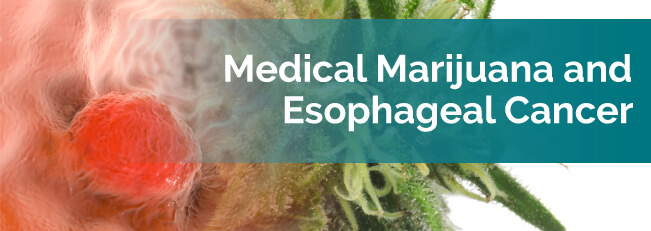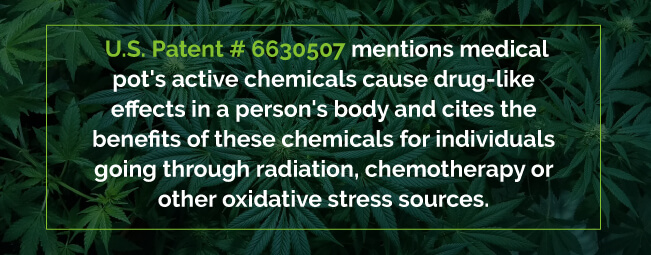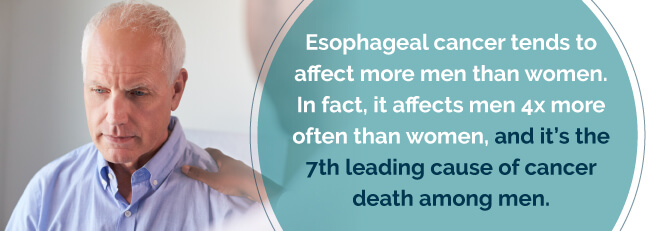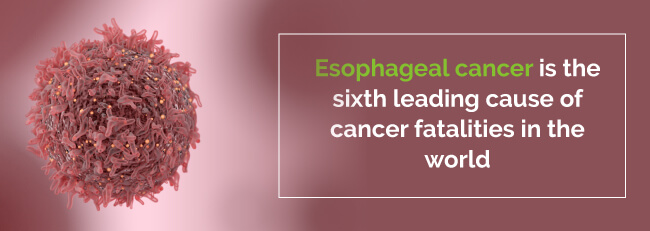
While it may be challenging for patients who live in prohibitionist states to access medical cannabis, the multiple benefits of medical marijuana for esophageal cancer and its most widely used treatment, chemotherapy, are indisputable. This marijuana and esophageal cancer guide provides you with information on the disease and how medical cannabis can help you manage the condition and its treatment side effects.
Food and liquid pass from the mouth to the stomach through a muscular tube called the esophagus. Sometimes the cells of the esophagus become cancerous. When the cells of the esophagus divide without order or control, it is called esophageal cancer. There are two types of esophageal cancer: squamous cell cancer and adenocarcinoma. The lining of the esophagus is made up of flat, thin cells called squamous cells. Squamous cell cancer develops in the upper and middle part of the esophagus. In addition to the squamous cells, the esophagus contains granular cells. The granular cells make and release mucus and other fluids that help with digestion. If stomach acids back up into the lower part of the esophagus the acids may irritate the granular cells, causing the cells to change. These changes can lead to cancer in granular cells called adenocarcinoma. Symptoms of esophageal cancer include difficulty swallowing, severe weight loss, pain in the throat, back or behind the breastbone, vomiting or hoarseness. Esophageal cancer can spread, metastasize, to other organs in the body. Surgery is the most common treatment for either type of esophageal cancer. Radiation and chemotherapy may also be used. New types of treatments such as laser therapy and photodynamic therapy may be used to ease symptoms. Learn more below about how medical marijuana can help treat esophageal cancer.
Medical marijuana smoke contains some of the same carcinogens found in tobacco smoke and a higher concentration of benzopyrene or other aromatic hydrocarbons. These prompt a tobacco-use related cancer fear in people inhaling cannabis regularly. Unlike tobacco smoke, researchers haven’t conclusively associated cannabis smoke with cancer in people, including cancers linked with tobacco use.
Find A Doctor Find A Dispensary
And marijuana and esophageal cancer smoke contain CBD and THC, two cannabinoids, which aren’t carcinogenic and have anti-cancer properties in vitro and in vivo. Nicotine, on the other hand, promotes cancer cell development and the blood supply.
Additionally, cannabinoids stimulate other responses and biological activities, potentially diminishing smoke’s carcinogenic effects.

There’s no secret to the medicinal benefits of weed. In fact, the government patented medicinal cannabis in October 2003 under the U.S. Patent # 6630507, revealing cannabinoids have antioxidant properties. The patent also mentions medical pot’s active chemicals cause drug-like effects in a person’s body and cites the benefits of these chemicals for individuals going through radiation, chemotherapy or other oxidative stress sources.
To add to this, Rick Simpson, the legendary medical marijuana activist, testifies cannabis oil healed his cancer — and all it may take is an extra dose of this powerful medicinal herb to undo chemotherapy’s potential carcinogenic effects.
You may think that marijuana use can cause head and neck cancers like esophageal cancer. After all, tobacco causes cancer, so smoking marijuana will too, right? Unfortunately, we don’t have any research conclusively pointing to marijuana causing cancer — in fact, a lot of the evidence shows no connection at all.
A review of scientific literature on cannabis use and cancer in the head and neck showed no link between the two. Researchers examined six articles containing a total of nine case-control studies and used meta-analysis software to assess the data collected in each study. Then, they calculated the odds ratio of the studies’ results, meaning they estimated the link between the two factors. The results of the meta-analysis indicated the marijuana use had nothing to do with the cancer incidence.
Also, a large-scale study including 108 esophageal cancer patients showed no solid link with marijuana. The numbers showed a slightly positive association between cannabis use and esophageal cancer. But, the population of the study who had the disease tended to be older than subjects with other conditions and the control group. Plus, the team pointed out that all the study’s results had no statistical significance when other factors came into play.
Some of the main side effects medical cannabis for esophageal cancer can treat include:
The American Cancer Society reports some smaller studies of smoked cannabis show it helps treat nausea and vomiting due to chemo. Other studies show inhaled cannabis, whether vaporized or smoked, helps treat damaged nerve pain, known as neuropathy. For some time, more studies have been revealing marijuana extracts reduce the need for pain medication.
Scientists more recently report cannabinoids like THC and CBD slow cancer cell growth or even cause their death in certain types of cancers. Animal studies also show certain cannabinoids reduce some types of cancer from spreading.
Earlier clinical trials involving cannabinoids as a treatment for cancer in people exist, and clinicians plan more.
Marijuana and esophageal cancer treatment can help treat adverse chemo side effects — even the most debilitating ones. When you’re undergoing chemo for your esophageal cancer, you may gain substantial relief even if you don’t do anything more than vaporize, smoke or eat your medical weed before you attend a treatment session.
However, it’s essential to find the right cannabis and esophageal cancer strains first. Below is a list of strains beneficial for treating cancer and its treatments.
Nausea-killers include:
Pain-killers include:
For appetite loss, try:
Help ward off depression and anxiety with:
Fatigue-fighters include:
It may take you some trial and error before you get the right mix of strains. Don’t worry though — many strains are available, and you’ll be sure to find a few to relieve your symptoms.
If you decide you’d rather not smoke your medical cannabis, you always have the option of vaporizing either raw cannabis flowers or concentrates like oils, resin, BHO or CO2. Edibles are another popular option.
You have even more options for your body to absorb the cannabinoids of medical weed, including:
These are all faster ways than edibles to get relief for your symptoms.
Talk with your doctor about trying marijuana for esophageal cancer to see if it’s the right treatment option you can use to not only treat your cancer but also the harsh treatments that go along with it. Browse our database of medical marijuana dispensaries or search for a medical marijuana doctor today.
Find A Doctor Find A Dispensary
As its name implies, esophageal cancer occurs in your esophagus. Your esophagus is the hollow, long tube running to your stomach from your throat. It helps push your food down to your stomach from the back of your throat for digestion.

Esophageal cancer typically begins in the cells lining the inside of your esophagus. But you can develop this cancer anywhere on your esophagus. Esophageal cancer tends to affect more men than women. In fact, it affects men four times more often than women, and it’s the seventh leading cause of cancer death among men.
Esophageal cancer dates back to circa 3000 B.C., in ancient Egyptian times. Since then, it’s seen a steady diagnosis and treatment rate.
For several centuries now, the medical field has made advancements in the visualization of these lesions as well as their removal techniques. Unfortunately, this hasn’t increased survival rates. Researchers finally made progress in the 21st century in early detection, diagnosis and survival rates.
There are two main types of esophageal cancer that doctors name for its malignant cells. These include:
The number of adenocarcinomas have been increasing over the past 40 years and are now a common form of esophageal cancer — the most common, in fact. It almost always occurs with Barrett’s esophagus and primarily affects white males.
Many believe chronic inflammation from acid in the stomach causes Barrett’s esophagus. When this occurs, it’s usually a defect in the sphincter of your lower esophageal separating your esophagus from your stomach. Patients who have chronic gastroesophageal reflux disease (GERD) have a high risk of getting Barrett’s esophagus and because of this, are at an even higher risk of getting esophageal adenocarcinoma.
There are typically no symptoms in earlier stages of esophageal cancer. When you do have symptoms, they might include:
Having some of these symptoms doesn’t always indicate the presence of esophageal cancer. Still, you should let your doctor know about them since they could signal another health issue.

Several factors can change your physical health, including your overall health, the stage of your cancer and the dose and length of your treatment.
You may experience physical side effects even after you’ve finished your treatment. These are long-term side effects and can last for months or years after the late effects of your treatment. Part of your survivorship care should treat both late and long-term side effects.
You may have social and emotional effects as well after you receive a diagnosis of cancer. This could include having to deal with difficult emotions like:
You might find it challenging to express how you’re feeling to the people you love. They may not know what to say to you in return for you opening up to them.
After receiving an esophageal cancer diagnosis, you know you’ll be up against a huge mountain. You likely know the odds and statistics of curing the disease and how they relate regarding the stage and prognosis of your esophageal cancer. And while treatment is a critical necessity to eliminate esophageal cancer from your body, you still need to keep yourself in good emotional health so you can sustain good quality of life.
Regardless of whether you have a good or poor prognosis for your esophageal cancer, you still need to face the emotional aspects of your diagnosis and engage with others. Engaging with others who either have esophageal cancer or who survived it is an excellent resource for you during what may be one of the most challenging times in your life. Support groups can give you a way of connecting with other people in the same situation.
Your treatment plan for your esophageal cancer should equally focus on eliminating the cancer from your body, maintaining your emotional health and managing your discomfort and pain. Your complications and side effects of your cancer and its treatment can be managed to allow you the ability to live a full and happy life. Medical marijuana can help.
According to estimates by the American Cancer Society for 2017:
National Center for Biotechnology Information (NCBI) statistics show:

Also, esophageal cancer is the sixth leading cause of cancer fatalities in the world. However, incidence rates in various geographic locations vary. A higher prevalence rate of esophageal cancer exists in some locations due to nutritional habits and obesity or alcohol and tobacco use.
The treatments your doctor prescribes for your particular case of esophageal cancer depend on the stage of your cancer, the cells involved in your cancer, your preferences for treatment and your overall health. However, common treatments include:
Your doctor may use cancer removal surgery by itself or along with other treatments. There are several types of surgeries your surgical oncology team may try, including:

Any esophageal cancer surgery comes with risks of bleeding, infection and leakage of the surgery site. Other side effects could include:
How your surgeon performs your surgery depends on your situation and their approach to managing it.
You may receive treatments for dysphagia, or difficulty swallowing, and esophageal obstruction, including:
Chemotherapy kills cancer cells using drugs and chemicals. The surgeon may give you chemotherapy before or after your surgery when you have esophageal cancer. The side effects you experience after chemo depend on the medications used. But side effects are typically:
With this procedure, your surgeon uses high-powered x-ray beams to kill your cancerous cells. Usually, the doctor delivers radiation outside your body with a machine to aim external beam radiation at your cancer. In some cases, although uncommon, they place the radiation near cancer inside your body in a process called brachytherapy.
Radiation therapy may also help relieve complications when your esophageal cancer is more advanced. For instance, the doctor may administer radiation therapy if you have a tumor so large it stops food from being able to pass to your stomach.
Radiation therapy side effects may include:
Your oncologist may try to enhance the effectiveness of your treatment, relieve symptoms of your cancer if it has spread beyond your esophagus or to give you a better quality of life by combining both radiation therapy and chemo. You may have this combination alone or before surgery. But there is a risk of more intense side effects when you receive these two combined.